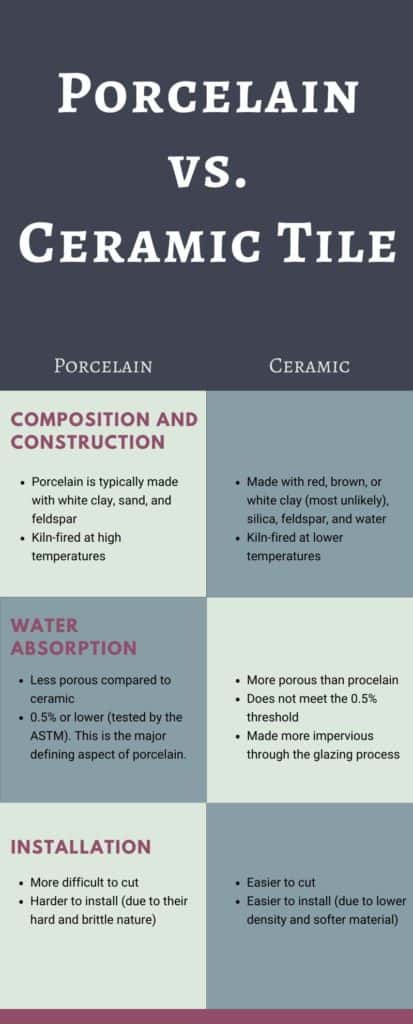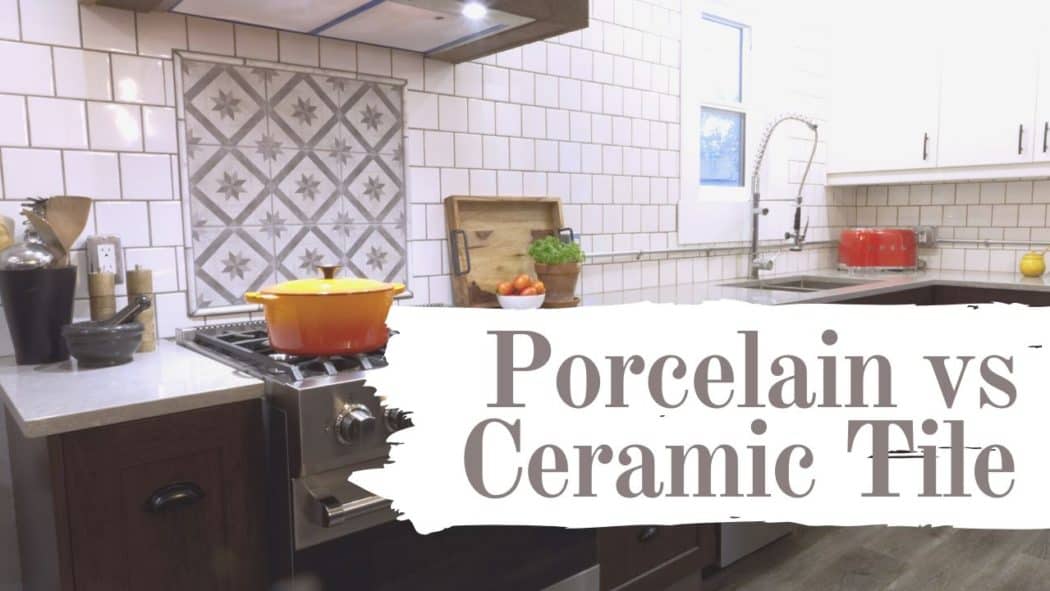Have you ever wandered into a tile shop and left with more questions than answers? I want to discuss one of the most common questions we receive by email; What tile should I use? This is a debate as old as the hills- porcelain vs ceramic tile.
I’ve run into more than one sales person who used these terms interchangeably. On the other hand, I’ve encountered just as many folks who describe these tiles like summer vs winter, as though they aren’t even remotely close. Hint…this is usually to pump up porcelain tile and justify the increased price tag.
So is porcelain vs ceramic tile really worth the debate? Are they all that different? The truth is porcelain tile is a type of ceramic tile. Confused yet? Although they are relative different in final product, porcelain vs ceramic tile tends to be an overblown debate.
Definition: Porcelain vs Ceramic tile
Porcelain tile
As I just mentioned, porcelain tile is a type of ceramic tile. Specifically, it is a ceramic tile than has an absorption rate under 0.5%. Interestingly, this is specifically tested by the American Society for Testing and Materials. The fired tile is weighted, boiled for 5 hours, and then left to sit in water for 24 hours. Finally, it is weighed again. If the tile weighs within 0.5% of its original weight, it is considered porcelain.
Porcelain tile uses clay, sand, and feldspar in the manufacturing process. They are fired at extremely high temperatures (1200-1400 degrees Celsius), leading to a hard and dense tile.
They absorb almost no water, leading to a hard-wearing tile. However, this also makes them more brittle in nature.
After being fired in the kiln, the tiles can be left in their natural state or transformed to look like stone, concrete, wood, or almost anything nowadays.
Porcelain tile can be either glazed or unglazed. Unglazed tile, sometimes called full-bodied tile has the color running through the entire thickness. Whereas, glazed tile has a top coating to increase durability and resistance to chipping.
Ceramic tile
Ceramic tile is also manufactured with clay, sand, feldspar, silica, and water. Sounds pretty similar to porcelain tiles right? Not so fast. If it’s absorption rate is over 0.5%, it cannot be considered a porcelain tile. In fact, the remaining ceramic tile typically has a water absorbing rate around 3%.
Ceramic tile is typically made with red or brown clay, which is softer and less dense. They are kiln-fired at a lower temperature (~1200 degrees Celsius) and the composition is less refined with more impurities in the clay, leading to a softer less dense tile.

Pros and Cons of Porcelain Tile
Marketing and branding has gone a long way in creating the mystique of porcelain tile. Companies like to discuss the long history and storied pass of porcelain tile, tying it to the quality of fine white china, which is expensive and rare. Interestingly, not much of this actually applies to the porcelain tiles you can purchase today. Most porcelain tile today is imported (this refers to North America). Although it is labelled as porcelain, up to 70% of this tile is likely not authentic porcelain.
Pros
Porcelain tile is known as the most durable type of tile on the market. It is harder, denser, and less porous than ceramic tile.
It is best suited to flooring for long lasting durability. Porcelain tile can be used on walls, however, weight must be taken into account. The denser clay can lead to increases if overall weight and this should be considered prior to purchasing.
Porcelain tile can be used for both interior and exterior applications.
Cons
Porcelain tile requires more experience to cut. Unlike ceramic tile which can be cut manually, porcelain tile typically requires a wet saw or angle grinder with diamond blade.
It is more expensive than ceramic tile.
Although this tile can be made to look like many different materials, it is still typically very simple in design. Fancy geometric, floral, or Moroccan patterns are more commonly found in ceramic tile.
Finally, weight. Porcelain tiles have a tendency to be slightly heavier. This wouldn’t be an issue in most newer homes. However, if you have an older home or an attic conversion where 2×4’s or 2×6’s make up the floor joists, you may want to skip porcelain tiles (really tile in general) as a flooring.
Pros and Cons of Ceramic Tile
It can get a bit complicated because ceramic tile can be further broken down into 3 groups- glazed, unglazed, and porcelain. This section is going to focus on glazed ceramic tile.
Most of the tile in the big box stores falls under this category, including everything from subway tiles to many of the sheet mosaics.
Pros
Ceramic tile can be cut manually or with a wet saw, making it far easier to work with. You can see in the short video below how I am easily able to make a rounded cut for a shower valve. Yes, I am putting ceramic tile in a shower/tub surround.
It can be purchased in more intricate and trendy designs and patterns. With the glazing and design process, ceramic tiles come in a variety of designs on their surface.
Ceramic tiles are cheaper than porcelain tiles. This doesn’t necessarily mean they aren’t as good. It is just cheaper to manufacture ceramic tiles, leading to a cheaper store price.
Cons
Ceramic tile is more prone to cracking (location and temperature dependent). This is most commonly seen when the surface isn’t properly prepared or the tile isn’t installed correctly.
The tile can chip or crack when cutting. The soft nature of ceramic tiles can be both a blessing and a curse. The glazing can chip with cheaper manual tile cutters or dull diamond blades. This can leave an installation looking poor and unprofessional.
This type of ceramic tile cannot be installed outdoors.
Unglazed ceramic tile
This type of ceramic tile must be sealed to protect the surface against stains and liquid penetration. The grout lines should also be sealed to prevent moisture from entering. Improper sealing could result in mold growth between and behind the tiles leading to even bigger problems.
Porcelain vs Ceramic tile: Where should they be used?
For starters ceramic tile should only be installed indoors. It is not durable enough for exterior use. Ceramic tile absorbs too much water and is not suited to handle constantly changing temperatures. Although the same does not apply to porcelain tile, it really depends on the location you plan to install porcelain tile. In some cases (think patios), alternative materials such as natural stone, quarry tile, or concrete is more suitable. This is also geographically dependent and a ‘one size fits all’ approach should not be taken.
If you plan to use exterior porcelain tile, consult the Porcelain Enamel Institute (PEI) ratings to determine their suitability.
- PEI 0 – No foot traffic (wall tiles)
- PEI 1 – Very light traffic (bathroom)
- PEI 2 – Light traffic (bathroom or bedroom)
- PEI 3 – Light to moderate traffic (most domestic use)
- PEI 4 – Moderate to heavy traffic (domestic and some commercial)
- PEI 5 – Heavy traffic (suitable for all uses)
Whether it is ceramic or porcelain tile, the manufacturer will recommend the best install location. Some tile is only suited to walls, whereas others are designed to be installed on both floors and walls. This comes down to the PEI rating for durability. Most ceramic tiles will have a PEI rating on the packaging.
Durability
The clay used in porcelain tiles is more dense and less porous, leading to a tile that is both harder and more impervious to moisture. When it comes to heavy traffic, the full body composition of porcelain contributes to a more durable tile.
Porcelain tile chips are nearly invisible, whereas chips in the ceramic glaze will reveal the reddish brown or grey clay underneath.
That being said, ceramic tiles are extremely durable and nearly impossible to crack without intentionally doing so. Just like porcelain tiles, properly installed ceramic tiles can last for several decades.
Maintenance
Porcelain tile is one of the easiest flooring options to maintain. It typically consists of a natural stain and is nearly impervious to water making maintenance a cinch. Spills are easily wiped away from the tile surface. The same goes for glazed ceramic tile.
However, be warned that grout isn’t always so easy. Grout needs to be sealed regularly (every couple years depending on location and use) to help minimize staining. Even then, lighter grouts can build up dirt and residue over time becoming dingy and dull.

Some final thoughts
More expensive doesn’t always mean better. It’s important to choose a tile that looks good and fits your daily life.
Think about the location of your project and how the space will be used. Is it going to have constant foot traffic like a kitchen? Or will it be on the wall of your shower?
If you are a weekend warrior or occasional DIYer, ceramic tile may be the better option. It’s easier to work with, friendly on the budget, making a few broken tiles less of a headache.
Make sure to leave a comment below with your insights or past experience. Good luck tile hunting! It’s one of my favourite parts of the design process.
You may also enjoy:


No Comments